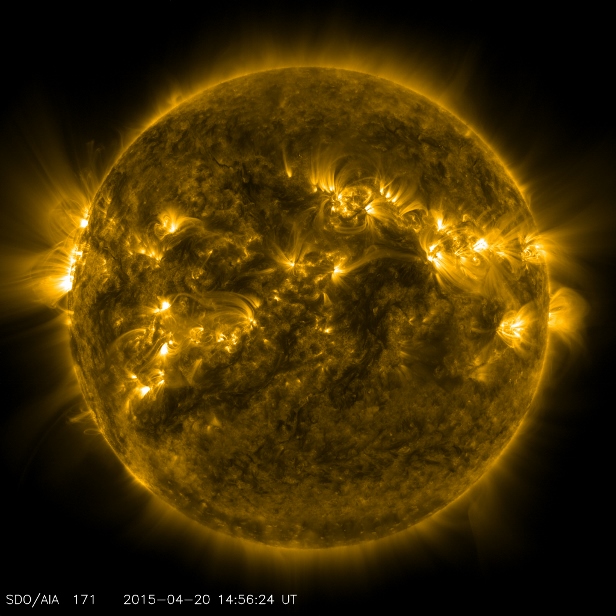Astronomers watch the Sun through a microwave lens
Observing the Sun’s microwave emission has revealed new information about the star’s solar flares

Bright spots and illuminated arcs of solar material hovering in the sun’s atmosphere highlight what’s known as active regions on the Sun, and these areas give rise to solar flares. Image credit: NASA/SDO
The Sun is a rather well-studied star, so it’s always exciting when we get the opportunity to observe it in a new way. One such opportunity is upcoming, via NASA’s Parker Solar Probe that was launched on 12 August 2018. But while scientists wait for that new view of the Sun, they have another one to examine: the Sun in microwaves.
In new efforts to better understand solar flares — sudden eruptions that occur when magnetic energy is abruptly released from the Sun, sending a burst of particles and radiation into space — we’ve observed these phenomena across a wide range of wavelengths. One wavelength regime known to be valuable for understanding the physics of solar flares is that of microwaves, which are emitted by high-energy electrons that are accelerated as energy is released in the flare.
But before now, the vast majority of microwave studies of solar flares have relied on data from the Nobeyama Radioheliograph in Japan, which observes the Sun at just two fixed frequencies that lie well above the peak of the microwave spectrum. This spectral regime explores only regions of high magnetic field strength.
What could we learn about solar flares from the lower-frequency microwaves emitted from more weakly magnetised regions? A newly upgraded array, the Expanded Owens Valley Solar Array (EOVSA) in California, United States, is now helping us to answer this question.

EOVSA now consists of 15 antennas capable of viewing the Sun in a lower-frequency wavelength. Image credit: Catherine Kirkeby
After its recent upgrade, which concluded in April 2017, EOVSA now consists of 15 antennas — which produce imaging and spectroscopy data that span the microwave spectrum, including lower microwave frequencies. In a recent study led by Dale Gary of the New Jersey Institute of Technology, United States, a team of scientists has presented the first example of microwave imaging spectroscopy from EOVSA, demonstrating the powerful new observations capable with this technology.
As a target to test the array’s capabilities, Gary and collaborators selected a solar flare that occurred on the limb of the Sun — i.e., the edge of its disk, as seen from Earth — in September of 2017: SOL2017-09-10.
High-frequency microwave observations of flares like SOL2017-09-10 had already demonstrated the presence of high-energy electrons in regions of high magnetic fields, like the small closed magnetic loops anchored in the Sun’s surface. But EOVSA’s view of the whole microwave spectrum has revealed that the spatial extent of high-energy electrons is much larger than we thought — these energetic electrons also lie well above the small reconnected loops, in the space between the loops and an erupting rope of magnetic flux associated with the flare.
This discovery indicates the necessity of some amendments to our standard model for the physics of solar flares. Though these early results from EOVSA may be preliminary, they clearly demonstrate the powerful capabilities of this new technology. We can look forward to more new observations of the Sun in the future, continuing to advance our understanding of how energy is released from our nearest star.
Keep up to date with the latest news in All About Space – available every month for just £4.99. Alternatively you can subscribe here for a fraction of the price!




